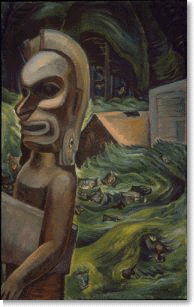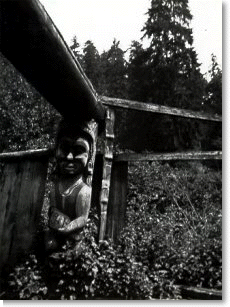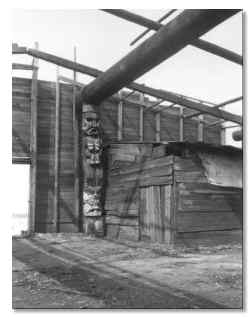Xwatis


"Like the D'Sonoquas of the other villages she was carved into the bole of a red cedar tree. . . . No violence coarsened her; no power domineered to wither her. She was graciously feminine. Across her forehead her creator had fashioned the Sistheutl, or mythical two-headed sea-serpent. One of its heads fell to either shoulder, hiding the stuck-out ears, and framing her face from a central parting on her forehead which seemed to increase its womanliness."
Carr 1941:57
Carr is mistaken. The inside housepost represents a noble male ancestor of the Gusgimaxw family which owns the house and the privilege; he is holding a copper under his left arm and is wearing a sisiyul headdress.
"As I grew older, my apprehension about masks changed to awe and a different understanding of their significance. Each mask took on the life and spirit of the persona it represented. Dzunuk'wa took on the spirit of womanhood gone mad, one who defied the most primal maternal instinct to protect children and instead threatened them."
Chief Robert Joseph, Gwawa'enuxw tribe, 1998:22
Dzunuk'wa was a giant female figure, twice the height of an average human. She has a black, hairy body, pendulous breasts, sleepy eyes that are said to glow like coals set in sunken eye sockets and pursed lips which indicate her cry "uu-huu-uu."
She creeps through the forests searching for children whom she captures and carries in a basket on her back to her remote house deep in the woods. There she plans to eat them. One child always manages to outwit her and escape; eventually Dzunuk'wa is killed by a warrior. Those who vanquish her assume the Dzunuk'wa as a dance privilege or represent her as a crest image on a totem pole, housepost or potlatch figure.
It is said that Dzunuk'wa has poor vision and is somewhat stupid. She can be put to sleep if one points an index figure at her and slowly moves it in a circular motion. She steals smoked salmon and other food from humans. When she is in difficulty, she will reward those who assist her with food or other wealth. She controls the water of life and can bring back the dead by sprinkling this magic liquid on them. Her power is such that her very presence causes mortals to swoon or have nightmares.
Carr's first significant encounter with a Dzunuk'wa image came in 1912 at Gwa'yasdams, a Kwakwaka'wakw village on Gilford Island. The twenty foot high carving had been erected in anticipation of a marriage transaction between a chief and his father-in-law. Carr had no idea of the meaning of this figure, as her subsequent correspondence with C.F. Newcombe reveals:
Newcombe's instruction allowed her to identify and comment briefly on Dzunuk'wa in her 1913 Lecture on Totems. Much later, in Klee Wyck (1941) in the chapter 'D'sonoqua', Carr created a romantic impression of her own relationship with the 'wild woman of the woods'. She expanded her 1913 narrative with two additional accounts about carvings in Tsaxis (Fort Rupert) and Xwatis where she sketched in 1930.

The Fort Rupert Dzunuk'wa housepost was part of a surviving houseframe which she described as follows:
"It was in one of these empty skeletons that I found her again. She had once been a supporting post for the great centre beam. Her pole-mate, representing the Raven, stood opposite her, but the beam that had rested on their heads was gone. The two poles faced in, and one judged the great size of the house by the distance between them. The corner posts were still in place, and the earth floor, once beaten to the hardness of rock by naked feet, was carpeted now with rich lush grass.
"I knew her by the stuck-out ears, shouting mouth, and deep eye-sockets. These sockets had no eye-balls, but were empty holes, filled with stare. The stare though not so fierce as that of the former image, was more intense. The whole figure expressed power, weight, domination, rather than ferocity. Her feet were planted heavily on the head of the squatting bear, carved beneath them. A man could have sat on either huge shoulder. She was unpainted, weather-worn, sun-cracked, and the arms and hands seemed to hang loosely. The figures were thrust into the carven mouths of two human heads, held crowns down. From behind, the sun made unfathomable shadows in eye, cheek and mouth. Horror tumbled out of them."
Carr 1941:50-51
The house had belonged to Chief Nakapenkim; Kwakwaka'wakw artist Mungo Martin later inherited that chiefly name and built a smaller version of the house in Thunderbird Park, Victoria, in 1953. Carr is incorrect in attributing the "pole-mate" as a raven. It is a huxwhukw, a cannibal bird of the middle heavens, said to use its long beak to crack open its human victims' skulls so that it can devour their brains.
The final description refers to her experience at the Xwatis, called by Carr the Cat Village:
"Like the D'sonoqua of the other villages she was carved into the bole of a red cedar tree. Sun and storm had bleached the wood, moss here and there softened the crudeness of the modelling; sincerity underlay every stroke.
"She appeared to be neither wooden nor stationary, but a singing spirit, young and fresh, passing through the jungle. No violence coarsened her; no power domineered to wither her. She was graciously feminine. Across her forehead her creator had fashioned the Sistheutl, or mythical two-headed sea-serpent. One of its heads fell to either shoulder, hiding the stuck-out ears, and framing her face from a central parting on her forehead which seemed to increase its womanliness."
Carr 1941:57
As Chief J.J. Wallas of Xwatis and many other knowledgable Kwakwaka'wakw experts have indicated, the carving represents a male ancestor. It bears none of the distinguishing features of Dzunuk'wa (sunken eyes, pursed lips, pendulous breasts).
On to Q'una
See more paintings of Xwatis
See more photographs of Xwatis
|

